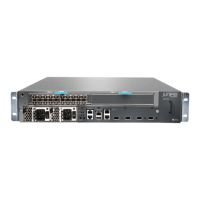To connect the DC source power cables to the router for each power supply:
1. Switch off the dedicated customer site circuit breakers. Ensure that the voltage across
the DC power source cable leads is 0 V and that there is no chance that the cable
leads might become active during installation.
2. Attach an ESD grounding strap to your bare wrist and connect the strap to one of the
ESD points on the chassis.
3. Switch the DC circuit breaker on the power supply faceplate to the off (O) position.
4. Remove the clear plastic cover protecting the terminal on the faceplate.
5. Verify that the DC power cables are correctly labeled before making connections to
the power supply. In a typical power distribution scheme where the return is connected
to chassis ground at the battery plant, you can use a multimeter to verify the resistance
of the –48V and RTN DC cables to chassis ground:
•
The cable with very large resistance (indicating an open circuit) to chassis ground
is –48V.
•
The cable with very low resistance (indicating a closed circuit) to chassis ground is
RTN.
CAUTION: You must ensure that power connections maintain the proper
polarity. The power source cables might be labeled (+) and (–) to indicate
their polarity. There is no standard color coding for DC power cables. The
color coding used by the external DC power source at your site determines
the color coding for the leads on the power cables that attach to the
terminal studs on each power supply.
6. Remove the screws from the terminals.
7. Secure each power cable lug to the terminal with the screw (see Figure 36 on page 93).
Apply between 5 lb-in. (0.6 Nm) and 6 lb-in. (0.7 Nm) of torque to screw. Do not
overtighten the nut. (Use a number 2 Phillips screwdriver.)
a. Secure the positive (+) DC source power cable lug to the RTN (return) terminal.
b. Secure the negative (–) DC source power cable lug to the –48V (input) terminal.
CAUTION: Ensurethateach power cablelugseatsflushagainstthe surface
of the terminal block as you are tightening the screws. Ensure that each
screw is properly threaded into the terminal. Applying installation torque
to the screw when improperly threaded may result in damage to the
terminal.
Copyright © 2017, Juniper Networks, Inc.92
MX5, MX10, MX40, and MX80 3D Universal Edge Router Hardware Guide

